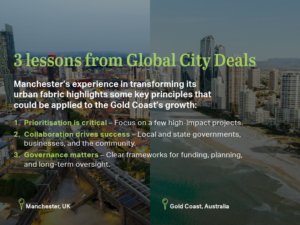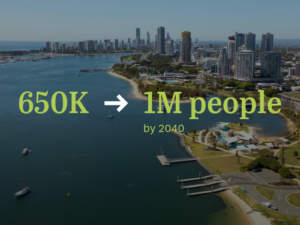Designing the Gold Coast’s future: lessons from global city transformations
The Gold Coast is on the brink of a new era, forecasting more than 30% growth by 2040. This comes with its challenges. How do you grow a city while retaining its unique identity?
Fortunately, others have paved the way, such as Greater Manchester Combined Authority (GMCA), which is made up of 10 local transport authorities (eight metropolitan boroughs and two cities). GMCA’s ambition is to unlock the future economic prosperity of Greater Manchester through strategic investment in its public transport network. This article shares lessons from GMCA’s Sustainable Transport Settlement, which followed its highly successful City Deal, for the Gold Coast’s next chapter.
What is the Greater Manchester Sustainable Transport Settlement, which followed its highly successful City Deal, and what’s the relevance to the Gold Coast?
Greater Manchester is a Mayoral Combined Authority (GMCA). Its elected Mayor is accountable for Transport investment priorities and oversees the transport body (Transport for Greater Manchester) responsible for the day-to-day operations of the public transport network.
The Government devolved public transport funding to local decision-makers who know how, when, and where it is best to invest locally. Greater Manchester’s City Deal (extending across a decade from 2012) saw significant investment of more than £1.5bn in public transport. The Metrolink Network expansion was the centre, which included completion of a new line from Manchester City Centre to Manchester Airport.
Following the City Deal, GMCA received a transport funding allocation of £1.17bn through the City Region Sustainable Transport Settlement (CRSTS) and added its own local contribution of £170m. Combined with other related funding (including cycling, walking and EV charging), GMCA accumulated c£1.5bn (2022-2027) in transport funding. With an indicative allocation of c£2.5bn for the follow-on 5-year period, this was one of the largest long-term investments in public transport outside London, at c£4bn over 10 years.
This settlement provides GMCA with the long-term funding security needed to plan for and bring about transformational change; and achieve its 2040 ambition of an integrated public transport network where 90% of journeys into the regional centre are taken by walking, cycling, and public transport. The combination of buses, trams and trains, with cycling, walking, integrated ticketing, customer information, and timetabling is all planned, developed, procured, delivered, and operated by GMCA.
Alongside the capital funding, GMCA is using its CRSTS and Bus Service Improvement Plan (BSIP) funding to invest in EV buses and smart ticketing systems (operational across bus and Metrolink, with a view to integrating local heavy rail services). This is part of the transition from private to public sector bus operations, becoming the first location outside London to move to a City Region franchised bus network. This network is operated by Transport for Greater Manchester (TfGM) on behalf of the GMCA.
Growth that works for people
The Gold Coast is defined by its lifestyle—beaches, open space, and a strong sense of community. But as the city expands, there’s increasing pressure to maintain what makes it special.
“The best part of the Gold Coast? The people. Here, people give things a go, lend a hand, and genuinely want to make a difference,” said Technical Director – Water Dominique Keirens.
For more than two decades Dominique has seen the Gold Coast evolve from quieter coastal towns into a thriving metropolitan hub. The challenge now is ensuring this growth enhances—not diminishes—the quality of life. That means planning for transport, housing, and essential services that keep pace with the city’s momentum.
Infrastructure that keeps up
A growing city needs a strong foundation. The Gold Coast’s transformation from a tourism-driven economy to a business and innovation hub depends on long-term investment in smart infrastructure.
“The Gold Coast isn’t just a beautiful place—It’s an emerging global city. Growth is inevitable, but how we shape it will define the city’s future,” said Gold Coast Program Management Director, Grant Haywood.
Lessons from Greater Manchester’s Transport Settlement offer valuable insights. In Greater Manchester, investment in infrastructure was tied to long-term economic returns. The city’s “earn back” model allowed for reinvestment in transport and public spaces, creating a cycle of sustainable development. This could mean a similar focus on transport connectivity for the Gold Coast, particularly as projects like the Light Rail expansion gain momentum.
Planning for resilience
Climate change, and sustainability challenges and opportunities will continue to shape how the Gold Coast develops. The recent impacts felt by ex-tropical cyclone Alfred are likely to become more normal. Ongoing and increased impacts likely to be felt through the city’s extensive coastline and waterways, which are critical to the lifestyle, economy and liveability of the city. The expected changes in the subtropical climate weather patterns and sea-level, overlayed with the city vision and planned growth, place sustainability and resilience at the centre of future planning considerations.
Proactive long-term planning for resilience is already underway across the broad range of city assets. To ensure we meet the challenges ahead we will need to extend the planning horizons further and consider the broader range of possible climate scenarios. We are not unique in facing these challenges with many cities and coastal developments around the world dealing with similar pressures. The difference will be in how responsive we are now in planning for and leveraging the opportunities around these scenarios through delivering on the themes that underpin the City Vision: Liveable Places, Connected Community, Diverse Thriving Economy, Naturally Unique, Vibrant Lifestyle, One City.
“We need to think about how people interact with the city—not just today, but 20 years from now,” said Associate Director – Landscape Architecture, Trevor Boobyer.
The Gold Coast has already made strides in sustainable urban planning, with projects like the Broadwater Parklands setting a strong precedent. However, as the population grows, more investment in resilient infrastructure—green spaces, flood mitigation, and smart transport systems—will be key.
“The pace of transformation provides an opportunity to enhance the resilience of the city’s mix of ageing and new assets while adapting to significant growth—not just in population, but in reputation,” said Technical Director – Asset Management, Frédéric Blin.
“Fast growing cities are both challenging and exciting, it’s important to keep in mind the management of ageing infrastructure while preparing for future demands. This needs a balance between sustainability, investment, and smart city planning.
The Gold Coast has already made strides in sustainable urban planning, with projects like the Broadwater Parklands setting a strong precedent. However, as the population grows, more investment in resilient infrastructure—green spaces, flood mitigation, and smart transport systems—will be key.

Developing and delivering complex programs of integrated public transport schemes (within busy/ urban/ built environments) takes time, requires significant funding, and can be hugely disruptive to a city’s daily life if not properly planned.
A scattergun approach will not work. Prioritising investment towards schemes that best meet pre-determined criteria (for example, outcomes/ benefits/ deliverability/ affordability) will provide a firm basis for successfully developing a long-term pipeline.
Another defining aspect of large complex programs is the extensive stakeholder landscape. Successful delivery is dependent on support and collaboration across multiple stakeholders along the development and delivery lifecycle. Taking the time to develop lasting relationships and collaborate with all key partners and stakeholders will not only make program teams more productive but also pave the way for the development and delivery of subsequent schemes in the pipeline.
Effective oversight and decision making is fundamental to the development and delivery of large pipelines of complex schemes, with tailored program controls providing the data analysis around schedule, cost and risk necessary to keep projects and the program on track.
Collectively, applying these core principles efficiently and effectively will help organisations develop a reputation for successful delivery, which is crucial to securing long-term funding settlements and strategic outcomes.
So, what next for the Gold Coast?
The Gold Coast is at a turning point. With the right mix of strategic investment, smart planning, and global insight, the city has an opportunity to become a leading example for sustainable, people-centred urban development. The challenge now is making the right choices—ones that set the city up not just for the next decade but for the next generation.
If you’re keen to learn more about how AECOM is helping transform the Gold Coast please contact Jacob Miethke (Area Manager, Gold Coast)







